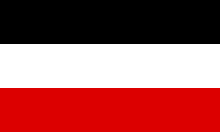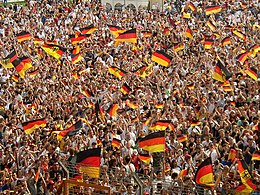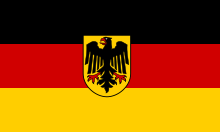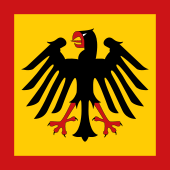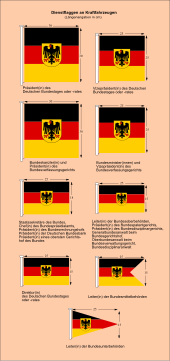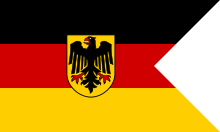Flag of Germany
| Federal flag | |
|---|---|
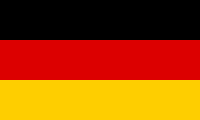 |
|
| Vexillological symbol : |
|
| Aspect ratio: | 3: 5 |
| Officially accepted: | July 3, 1919 (German Reich) re-accepted: May 23, 1949 (Federal Republic of Germany) |
The flag of the Federal Republic of Germany , officially the federal flag , is a German national emblem and state symbol ( Article 22 of the Basic Law for the Federal Republic of Germany ).
The revolutionaries of the 19th century, who wore the flag colors as clothing, referred to the flag as "tricolor", which is the German translation of the term "tricolor". The flag of Germany has no official name, but is sometimes simply called black-red-gold . The synonym federal colors or colloquially "Germany flag " is also in use. In sailing circles it is sometimes referred to as "Adenauer", based on the first Federal Chancellor Konrad Adenauer .
In addition to the federal flag, there is also the federal service flag for federal authorities, a naval war flag of the German Navy and a troop flag of the Bundeswehr .
description

The national flag of Germany is a tricolor made up of three horizontal bars of equal size with an aspect ratio of 3: 5. The colors of the federal flag are specified in Article 22, Paragraph 2 of the Basic Law of May 23, 1949:
"The federal flag is black, red and gold ."
Heraldically , the flag is described as “divided into black, red and gold”. The trade flag corresponds to the federal flag.
In addition, the order on German flags of June 7, 1950 regulates that the federal flag consists of three horizontal stripes of equal size, black above, red in the middle, gold below, and that the ratio of the height to the length of the flag cloth is 3 to 5 is. In Section I No. 1 of the flag arrangement of November 13, 1996, it was stipulated that the federal flag can also be carried in the form of a banner consisting of three longitudinal stripes of equal width, black on the left, red in the middle, gold on the right.
As far as the colors are concerned, the current FlaggAnO not only speaks of gold, but also in Appendix 1 of the Federal Law Gazette the lower stripe in the heraldically controversial, but historically justifiable metallic color. The Federal Ministry of the Interior recommended RAL 9017 (traffic black), RAL 3020 (traffic red) and RAL 1028 (melon yellow) for the colors of the flag fabrics. The corporate design of the federal government was developed on the basis of the decision of the Federal Cabinet of June 2, 1999 . The federal government uses the following RAL color values for images of the flag in print products and on screens , with their correspondence in the Pantone and CMYK system for word marks (" company logos ") and RGB for online media:
| colour | RAL | Pantone | CMYK | RGB (Hex) | |
|---|---|---|---|---|---|
| black | 9017 traffic black 2A 29 2A |
9005 jet black 0A 0A 0D |
Black | 0-0-0-100 | 0,0,0 (# 000000) |
| red | 3020 traffic red C1 12 1C |
3020 traffic red C1 12 1C |
485 | 0-100-100-0 | 255,0,0 (# FF0000) |
| gold | 1028 melon yellow FF 9B 00 |
1021 Rapeseed yellow EE C9 00 |
Yellow: 765 g, Red 032: 26 g, Black: 11 g, transp. White: 198 g, alternative 7405 |
0-12-100-5 | 255.204.0 (# FFCC00) |
history
Medieval flag
The heraldic combination of black, red and gold has been attested since the Middle Ages. A forerunner of the German flags is the imperial banner of the Holy Roman Empire . In the event of war, other flags were added, such as the Reichssturmfahne or, if the Kaiser was involved, the Reichsrennfahne .
- High Middle Ages until 1410: black one-headed eagle with red weapons (beak and claws) on a yellow-gold background (heraldic: "In gold, a black eagle with red weapons"). This eagle, together with the color combination black and yellow based on it, was the emblem of the Roman-German king and the colors of the empire . Since the 13./14. In the 19th century, its claws and beak were shown in red. The Heidelberg Codex Manesse gives the oldest evidence of this .
- Late Middle Ages from 1410 to 1806: black double-headed eagle with red weapons on a yellow-gold background. The double-headed eagle symbolizes the imperial and kingship of the emperor or king of the Holy Roman Empire, i.e. his prominent position among the other kings of Europe. After 1806, the double-headed eagle became the emblem of Austria under the Habsburgs, who held the title of Roman emperor for centuries and who, after the fall of the Holy Roman Empire, continued its colors, black and yellow, as Austrian emperors.
 ? Imperial war flag of the Holy Roman Empire (1200-1350)
? Imperial war flag of the Holy Roman Empire (1200-1350)
 ? Banner of the
? Banner of the
Holy Roman Empire until 1400 (artist's impression) ? Banner of the Holy Roman Empire from 1400 (artist's impression)
? Banner of the Holy Roman Empire from 1400 (artist's impression)
Holy Roman Empire of the German Nation (1410–1806, depiction by Albrecht Altdorfer )
Flags of modern times
One of the origins of the colors black-red-gold can be found in the Wars of Liberation against Napoleon in 1813 , namely in the uniforms of the Lützow Freikorps . The corps were mostly made up of students who formed against the occupation of Germany by France (see also Urburschenschaft ). Since the volunteers under the Prussian major Adolf von Lützow came from all parts of Germany and brought very different uniforms and civilian clothes with them, the only way to produce uniform clothing was to dye the differently colored uniforms black. In addition, there were gold (brass-colored) buttons and finally red lapels and a push . The fact that the colors were the same as those of the imperial flag in the Holy Roman Empire contributed to its popularization .
This color combination is also confirmed by a (historically guaranteed) saying from the Wars of Liberation:
"From the blackness (black) of bondage through bloody (red) battles to the golden (gold) light of freedom."

On June 17, 1813, the "Black Hunters" troops were ambushed by the French near Kitzen (near Leipzig) and were almost completely wiped out. On June 12, 1815, seven students who had served in the Lützow Freikorps and were now active in various corps of the Senior Citizens' Convention in Jena , joined other nationally and republican-minded students to found the Urburschenschaft . They chose the colors "black-red-gold".
On the fourth anniversary of the Battle of the Nations near Leipzig , on October 18, 1817, around 500 students from the original fraternity and some professors from many German states marched with the red-black-red flag under the slogan “Only the whole thing is salvation” (only the Fringes and an oak branch in the black stripe) on the Wartburg near Eisenach ( Wartburg Festival ) to demonstrate for freedom and a unified empire. From May 27 to May 30, 1832, 30,000 participants demonstrated at the Hambach Festival for national and democratic goals and for the first time carried a black, red and gold flag with them. The inscription in the middle red part "Germany's rebirth" made the aim of those involved clear, the establishment of a German nation-state .
German Confederation
The colors black, red and gold did not establish themselves as German national colors until the period of the German Confederation (1815–1866) in the first half of the 19th century . On March 9, 1848, the Bundestag officially adopted these colors and fixed the flag with the horizontal colors black, red and gold.
Revolutionaries of 1848/49 who did not want German unity as a monarchy but as a republic also chose a vertically striped black, red and gold tricolor based on the French flag.
In the emerging German Empire of 1848/1849, the Frankfurt National Assembly passed an imperial law on November 13, 1848 regarding the introduction of a German war and trade flag . Black, red and gold were therefore also the colors of the imperial fleet . Because the colors were so widespread and seemed natural, they were not specifically mentioned in the Imperial Constitution of March 1849 . After the suppression of the revolution in May / June 1849, the federal decree of March 1848 was not reversed, but the colors were rarely used in public for a long time.
In 1863, however, the flag was waving over the Bundespalais in Frankfurt when the Frankfurt Fürstentag gathered. During the German War of 1866, some German federal corps fought against Prussia under the black, red and gold flag. Black and gold were also the colors of the old empire , these old empire colors were valid in Austria-Hungary until 1918.
At the end of the 1860s, flag designs by Prince Adalbert of Prussia for various German flags were discovered. In 1849/50, the founder of the German Reichsflotte primarily drafted proposals for a naval war flag and Gösch of the Reichsflotte, which were based on the black, red and gold flag of the German Confederation and combined the colors differently with an iron cross. As the national flag, Prince Adalbert proposed a horizontal tricolor in black, red and gold and a quartered flag with a rectangle in gold (on the upper leech), a black rectangle (in the lower flight part) and two red rectangles. Prince Adalbert also created a design for a flag for the Princely Council.
North German Confederation and German Empire
Prussia , the most influential German state since 1866, tried to steer German unification efforts in ways that corresponded to its own interests. The most important step in this direction was the founding of the North German Confederation in 1867. The Prussian Prime Minister Otto von Bismarck personally initiated the adoption of a new flag for the war in the constitution that came into force on July 1, 1867 (in Art. 55) and merchant navy: a black-white-red tricolor. These colors originally come from suggestions for flags by Adolf Soetbeer , Secretary of the Hamburg Chamber of Commerce , from an article published in the Bremer Handelsblatt on September 22, 1866. On December 9th, Bismarck pleaded for this combination in a first draft constitution of the North German Confederation, and Prince Adalbert von Prussia , the Prussian naval minister from 1848 to 1851, also spoke out in a lecture to the King and Crown Prince on December 25th, so that the colors finally became official on July 1, 1867 with the North German Federal Constitution . It was explained to the public that black and white stood for the Prussian and red and white for the Hanseatic cities . The Hanseatic League itself, as a league of cities, never had its own uniform flag, but the coats of arms of almost all member cities were white and red.
This coloring matched the colors of the King of Prussia, Wilhelm I, insofar as black and white were the colors of Prussia and red and white were those of the Mark Brandenburg . With the exception of Wilhelm himself, who was reluctant to take over the imperial dignity in 1871 and saw himself primarily as a Prussian, there was hardly any resistance to the black-white-red tricolor - the supporters of the Greater German colors black, red and gold were also the first step Unification of the German states more important than the colors of the flag. The North German federal colors, which were adopted as the colors of the Empire when the Empire was founded in 1871 , finally became the black, white and red national flag of the German Empire in 1892 under Kaiser Wilhelm II and developed into a patriotic symbol of the Empire that was widely recognized throughout Germany .
Weimar Republic
After the defeat in the First World War , this flag, which stood for the monarchical, militaristic and authoritarian system that collapsed during the November Revolution, was again replaced in the Weimar Republic by a flag in the colors black, red and gold (Art. 3 sentence 1 Weimar Constitution ). The introduction of the black-red-gold flag was accompanied by a flag dispute that lasted well into the 1920s, separating the camps of supporters of the parliamentary republic from their right-wing opponents, while the extreme left and the USPD favored the red revolutionary flag .
The decisive vote on the choice of national colors took place on July 3, 1919 in the Weimar National Assembly . There was a majority of 211 votes for black-red-gold with 90 against. A compromise was reached for the trade flag by adding a jack in the national colors of black, red and gold to a black, white and red basic scarf (Art. 3 sentence 2 Weimar Constitution). A similar compromise was reached in November 1920 for the even more controversial and highly symbolic Reich war flag for the military . In the First Flag Ordinance of July 31, 1921, additional flags were set, with five having black, red and gold and five black, white and red basic cloths. However, nobody liked this complicated arrangement, each camp regarded its colors as the true colors of Germany.
Monarchists and counter-revolutionaries viewed the change of national colors as a symbol for the political upheavals that they regarded as illegitimate and linked the new colors with the humiliation of the outcome of the war. In addition to the military, many national liberals also initially favored the reintroduction of the black-white-red flag, including Gustav Stresemann in 1921 . Right-wing nationalists and the National Socialists mocked the valid flag as "Black-Red-Mostrich" ( Mostrich = mustard). In the following years of the very emotional flag dispute, black-red-gold became the most important identification symbol of the democratic constitution supported by moderate forces, while the old imperial colors developed more and more from the originally purely monarchist symbol to the general identification mark of the anti-republican right. This gave both tricolors a political meaning that they did not previously have in this form. An expression of this polarization was the clashes and street fights between the political combat organizations that competed under different banners, such as the republican Reichsbanner Schwarz-Rot-Gold , the Red Front Fighters Association of the KPD and the right-wing conservative war veterans' association Stahlhelm , which had adopted black, white and red as its federal colors in 1920 and after the Nazi takeover of power in the SA .
National Socialism
In 1933 the National Socialists immediately removed all traces of the hated republican national colors "black, red and gold" from the national symbols and reintroduced the imperial national colors "black, white and red". During the time of National Socialism , the Nazi Party's swastika flag was quickly replaced by the black-white-red flag and finally replaced it entirely from 1935 onwards. Through this process, the increasing amalgamation of state and party into a dictatorship was also made symbolically visible.
First of all, both flags were supposed to represent Germany together: With a decree of March 12, 1933, President Paul von Hindenburg decreed that two flags in the German Empire were to be hoisted together “until the final regulation of the imperial colors”: on the one hand the old flag with the black and white -red stripes and additionally the swastika flag. Interior Minister Wilhelm Frick issued a decree on April 29, 1933 that black-white-red must be shown on the stern of merchant ships and the swastika flag must be shown in place of the signal flags.
The swastika on the back of the flag was also shown pointing to the right, while on the flags used at sea it was “colored through” in mirror image, i.e. H. was left-wing.
The swastika flag, introduced in the summer of 1920 as the NSDAP party flag, whose color combination red, white and black is reminiscent of the imperial flags, is said to have been designed by Adolf Hitler himself, along with other symbols of the National Socialists. In Mein Kampf, however, he admitted that a Starnberg dentist - probably Friedrich Krohn - had created a very similar design and probably influenced his design. In that one the swastika was only shown with curved hooks. Hitler read the flag as follows:
"The red cloth, the color of iron social justice, the white, our sacred national enthusiasm, and the swastika as a symbol of work."
In Mein Kampf , Hitler described this “creative” work as anti-Semitic , next to it the swastika would also stand “for the victory of the Aryan people”.
The swastika had been a popular symbol among supporters of the völkisch movement since around the turn of the century and in the period immediately after the First World War it had established itself as an emblem of belonging among soldiers, volunteer fighters and young people with a national attitude. At that time it was also taken up by National Socialism. Even before the start of the Nazi era, it was also used as a military badge in Latvia and Finland and was probably brought to Germany by Baltic fighters around 1919 , where it was already spreading as a right-wing national Freikorps and party emblem in the run-up to the Kapp Putsch would have.
About a year after Hindenburg's death, it was decided in the Reichsflaggengesetz of September 15, 1935 that from now on only the swastika flag (now with the swastika shifted to the left) was to be shown as the Reich and national flag. As President of the Reichstag, Hermann Göring justified the abolition of the black-white-red flag: It was important to prevent it from being “degraded” to a “party pennant” by reactionaries.
One reason for this change may have been the "Bremen incident" that took place in New York on July 26, 1935: shortly before the German liner "Bremen" cast off, a group of participants in an "anti-Nazi demonstration" arrived on the ship and removed the National Socialist swastika flag during a fight. It was torn up and then thrown into the Hudson River . Four days later the German ambassador handed the US government a sharp protest note complaining about the “desecration” of the German national flag. The US side pointed out, however, that the swastika flag was only a party flag and that the black, white and red national flag had in no way been attacked. This is sometimes interpreted as the final push for Hitler to change the flag law.
After the Second World War

 ? C ‑ double stand, identification flag for German merchant ships (1946–1951)
? C ‑ double stand, identification flag for German merchant ships (1946–1951)
3: 5 ? German Democratic Republic (1959–1990)


3: 5
 Flag of the all-German Olympic team from 1960 to 1965,
Flag of the all-German Olympic team from 1960 to 1965,
flag of both German states at the 1968 Olympics
1945 to 1949
After the Second World War , all previous national flags were banned by the victorious powers . On November 12, 1946, the occupying power ordered in Control Council Act No. 39 that all German ships had to carry the international signal flag of the letter "C" with a triangular cutout, the so-called C double stand, for identification. The colors blue, white and red represent the national colors of the four allies . This stander was not allowed to be greeted at sea, or certificates of honor were not given to him.
The preparations for the creation of a new German national symbolism began during the “Constitutional Convention on Herrenchiemsee” , which met between August 10 and 25, 1948. Although there were considerations to postpone the flag issue until reunification, it was finally decided to make a decision. This happened above all in response to the SED's draft constitution of November 22, 1946, in which black, red and gold were defined as the colors of a future “German Republic”. While the Social Democrats pleaded for the reintroduction of the old Weimar colors of black, red and gold, the CDU / CSU and the conservative German party considered it more appropriate to choose the “ cross flag ” of July 20, 1944 as the new German national flag. This flag, designed by Josef Wirmer , a resistance fighter of July 20, 1944, which should have been used as the provisional national flag after the successful assassination attempt on Adolf Hitler, was the basis of a later proposal by the Union parties on November 5, 1948. Josef Wirmer's younger brother Ernst was a member of the Parliamentary Council and on October 26, 1948, initially convinced the CDU / CSU delegates to adopt his brother's original draft. Josef Wirmer's idea of arranging the national colors in the form of a Scandinavian cross ( Wirmer flag ) was probably based on the idea that on the one hand the Wehrmacht was satisfied (through similarity to the Reich War flag ) and on the other hand the democratic forces were taken into account (by using the traditional democratic colors). His brother Ernst's design followed a similar idea, adding a black stripe between the yellow and red fields, analogous to the Wehrmacht's Balkenkreuz . However, this addition resulted in the heraldic problem avoided by Josef Wirmer that black directly bordered on red. However, on November 3, 1948, it was decided to keep the traditional border between red and black. In the draft of the legal text it said: "The flag of the federal government shows a black lying cross on a red background and a gold cross placed on top of it." The flag proposed by Wirmer is now mainly used in the context of the right-wing extremist and right-wing populist scene, especially in the context from PEGIDA , which the descendants of Wirmer are now resisting.
 ? Wirmer flag by Josef Wirmer , proposal for a provisional flag of Germany (1944)
? Wirmer flag by Josef Wirmer , proposal for a provisional flag of Germany (1944)
 ? Suggestion by Ernst Wirmer (1948)
? Suggestion by Ernst Wirmer (1948)
 ? CDU proposal for the federal flag (1948)
? CDU proposal for the federal flag (1948)
Other politicians, art historians and artists also dealt with the flag issue. Robert Lehr , a member of the Parliamentary Council, suggested a flag modeled on that of the United States , with a gold star inserted in the black jack of the red flag for each state. The historian Paul Wentzcke advocated a “Republican tricolor”, which, like the French tricolor , should be divided vertically. The art historian Edwin Redslob wanted to represent the division of Germany with a white horizontal stripe on the black, red and gold tricolor.
 ? Designed by Robert Lehr (1948)
? Designed by Robert Lehr (1948)
 ? "Republican Tricolor" by Paul Wentzcke (1948)
? "Republican Tricolor" by Paul Wentzcke (1948)
 ? Designed by Edwin Redslob (1948)
? Designed by Edwin Redslob (1948)
The fact that an agreement in favor of Black-Red-Gold was finally reached is mainly due to the fact that legal continuity between the Weimar Republic and the Federal Republic of Germany could be made clear.
Federal Republic of Germany 1949 to 1990
When the Basic Law came into force on May 23, 1949, the federal flag of the Federal Republic of Germany was set. Article 22 states: “The federal flag is black, red and gold.” However, the population had not yet fully adopted the new flag. In the weekly newspaper Die Zeit it was read that as many people use black-white-red as black-red-gold as a flag - 25% each. A survey by the Institut für Demoskopie Allensbach provides different figures: 35% of those questioned would choose black, red and gold. Half of the respondents did not want to make a decision. Despite different results, the surveys showed a highly divided opinion in society.
German Democratic Republic 1949 to 1990
In the Soviet occupation zone , the second People's Congress in 1948 decided to use the black-white-red flag, as used by the National Committee for Free Germany . In 1949, however, at the suggestion of Friedrich Ebert junior , the black, red and gold flag was also adopted as the flag of the German Democratic Republic . The German Democratic Republic added to the Flag Act of October 1, 1959 its national emblem - Ährenkranz with hammer and compass - in the middle of the flag a. The public display of this flag, officially designated as the "Soviet Zone Flag" by the Federal Republic of Germany, was viewed as a violation of the constitution and public order in the Federal Republic of Germany and West Berlin until the end of the 1960s and was prevented by police measures (see also Hallstein Doctrine , Sole representation ). A special flag dispute arose in West Berlin in 1959 when the new black, red and gold flag of the GDR was shown on the Reichsbahn premises. Because according to an allied agreement, the entire railway system within the boundaries of the city of Berlin was under the Soviet military administration and was therefore not easily controllable by the western police.

Since 1990

In the draft constitution of the Central Round Table for the GDR, which was handed over to the newly elected People's Chamber and the public in the spring of 1990 , there was also a black, red and gold flag in which the old GDR national coat of arms was replaced by the symbol of the GDR's independent peace movement " Swords to Plowshares ”was intended as the GDR state flag. But with German reunification , the flags of the Federal Republic also became valid in the east.
While Germans were very reluctant to deal with their flags and their national colors for a long time after the impressions of World War II, on the occasion of the 2006 World Cup, for the first time in German post-war history, there was a massive appearance of the German national flag and the German national colors on houses, Cars, clothing, fan articles and body paint have been seen.
German football fans during the 2006 World Cup
Heptathletes on the European Championship lap of honor in Barcelona 2010
German fan flag in the Gdańsk football stadium for the European Championship 2012
Service flag of the federal authorities
In addition to the federal flag, there is also the official flag of the federal authorities (short: federal official flag), the use of which is specified in the order on German flags of June 7, 1950:
“The official flag has the same horizontal stripes as the federal flag, on it, shifted a little towards the mast, in the black and gold-colored stripes each overlapping up to a fifth, the national shield , the eagle turned towards the mast. The ratio of the height to the length of the flag cloth is 3: 5. "
The unauthorized use of federal coats of arms and official flags can be punished as an administrative offense ( Section 124 OWiG ). This is to prevent these symbols from being invalidated through improper use. In addition, the reputation of the state should be protected. However, use is not unauthorized if the competent authority has permitted it or if it is to be regarded as socially adequate . This is the case, for example, when it is impossible to create the appearance of official use through use. The showing of a service flag by fans at a sporting event is therefore not unauthorized use under this provision.
Representatives of the German Bundestag and the Bundesrat often fly the federal flag instead of the federal service flag. This is intended to express their legitimation through and their solidarity with the people, who are only allowed to use the federal flag but not the federal service flag.
The Federal Post flag was on 7 June 1950 to 31 December 1994, an independent federal service flag, their use exclusively the Federal Post Office and the parent Ministry was allowed.
3: 5 ? Federal flag with federal eagle (wrong and disorderly, but largely tolerated variant)

3: 5 ? Bundespostflagge of the Deutsche Bundespost (until 1994)

Flag logo of the German ISAF contingent of the Bundeswehr in Afghanistan
( Persian lettering : "Alman"; Germany)
Flags of the naval forces

The German naval war flag is called the service flag of the naval forces of the Bundeswehr . It corresponds to the federal service flag, but is designed as a double stand. The federal shield is located roughly in the middle between the flagpole and the incision, but a little further away from the flagpole. The design of the service flag of the naval forces of the Bundeswehr thus differs from the earlier Reich War flags , which mostly showed the Teutonic Cross on the flag. The service flag of the naval forces is based on the flag of 1848, as it was also used by the Reichsflotte . It is thus in the democratic tradition of the " Paulskirchenregierung ".
The service flag of the naval forces was introduced on May 25, 1956 by order of the Federal President. It is carried by all warships of the German Navy and their dinghies. They also run permanently manned coastal stations. Civilian auxiliary ships of the Navy, bases and barracks of the German Navy fly the federal service flag.
The design of the command signs of the German Navy date from the time of the German Empire . They use the black iron cross on a white background as a basis.
Rules for flagging

Flag days
The Federal Government's decree on the flagging of federal official buildings of March 22, 2005 regulates the flagging days for which no special regulations are required:
- Day of Remembrance of the Victims of National Socialism ; January 27th as mourning flags (half-mast)
- Labor day ; 1st of May
- Europe Day (anniversary of the Schuman Declaration ); May 9 (1950)
- Anniversary of the proclamation of the Basic Law ; May 23 (1949)
- Anniversary of June 17, 1953
- Anniversary of July 20, 1944
- Day of German Unity ; October 3 (1990)
- Memorial day ; 2nd Sunday before 1st Advent (half-mast)
- Day of the election to the German Bundestag *
- Day of the election to the European Parliament *.
(* not in all federal states)
The federal flag at the main entrance is also raised on the days of the Bundestag. In addition, there are a number of regular flagging days in the countries. It is also common practice to use flags on other days, e. B. in the election of the Federal President or mourning flags on the death of an important domestic or foreign politician. For these flags to be used, an order from the Federal Minister of the Interior (usually) is required .
As a national monument, the flag of unity on the Reichstag is exempt from the flagging rules.
Banner flags
In addition to the normal horizontal format flags, banner flags are often used in public in town halls, schools and other buildings with flags. The black stripe should be on the left side from the viewer's point of view. It should be noted that only "real" banner flags are used in which the flag cloth is firmly connected to a cross bar at the short end. The banner hangs in the middle (with the red stripe) in front of the flagpole. The occasional portrait format variant in which a strip is attached to the mast (cantilever flag) is not permitted.
There have also been clear guidelines for the position of the coat of arms since the order on German flags of November 13, 1996 (sometimes called the Flag Act):
"If the federal service flag is used in the form of a banner, the federal shield, with the eagle turned towards the black stripe, is aligned parallel to the longitudinal stripes, shifted slightly towards the mast, and up to a fifth each in the black and gold-colored parts."
In most cases, the aspect ratio is not fixed, but the ratio of 5: 2 is the most common for banner flags.
Subnational flags
The federal states, administrative districts, administrative districts and municipalities have their own flags for their sovereign territory , and in some cases also have additional official flags.
Authorities of the federal states and municipalities use the federal flag together with their own official flags. Boats of the federal states (e.g. water police) use the federal flag as a service flag at sea.
Others
As with many flags, heraldic rules were disregarded in the design of the black, red and gold federal flag . After this, two colors may not be next to each other. They have to be separated by a metal (yellow = gold, white = silver). However, this rule only had limited validity for flags and is no longer relevant today.
On February 22, 1928, King Amanullah Khan of Afghanistan traveled to Germany for five days and visited Berlin and Munich . Since 1919, Germany had supported the Afghan government and people financially, politically and culturally in almost all areas of infrastructure, technology and education. Allegedly, Amanullah Khan was inspired by the shape and color of the black, red and gold flag of Germany, because in the same year a three-color flag with horizontal stripes in black, red and green was introduced in Afghanistan for the first time . The white national coat of arms adorned the center.
See also
- Flag of unity
- Flags of the national minorities in Germany
- Flag of Prussia
- List of flags of the German Empire
- List of flags of all of Germany
- Wirmer flag # Proposal as the national flag of the Federal Republic of Germany
literature
- G. Anrich, A. et al. G. Cronford: The Flag Book . Otto Maier, Ravensburg 1983, ISBN 3-473-38851-3 .
- Jörg-M. Hormann, Dominik Plaschke: German flags. History, tradition, use. Edition Maritim, Hamburg 2006, ISBN 3-89225-555-5 .
- Ottfried Neubecker: Heraldry. Wolfgang Krüger Verlag, Frankfurt am Main 1977, ISBN 3-8105-1306-7 .
- Erardo Cristoforo Rautenberg : Black-Red-Gold: The symbol for the national identity of the Germans! In: Messages from the Federal Archives. Issue 3-2002, pp. 5-21; Yearbook of the Hambach Society 2003. pp. 227–246; 2008 updated version published by the Brandenburg action alliance against violence, right-wing extremism and xenophobia ( PDF file , 2.31 MB).
- Peter Reichel : Black-Red-Gold. A short history of the German national symbols. Beck, Munich 2005, ISBN 3-406-53514-3 .
- W. Smith, O. Neubecker: The signs of men and peoples. Our world in flags and banners. Reich Verlag AG, Lucerne 1975, ISBN 3-7243-0115-4 .
- Veit Valentin , Ottfried Neubecker : The German colors. Leipzig 1929.
- Paul Wentzcke : The German colors, their development and interpretation as well as their position in German history. (Sources and representations on the history of the fraternity and the German unity movement, 9), Heidelberg 1927, 2nd edition. 1955.
Web links
- Flags of the World - Germany (English)
- Ordinance on German flags of April 11, 1921
- Order on the German flags of November 13, 1996
- Flagging decree of the federal government of March 22, 2005
- Corporate design of the federal government
- "Black-Red-Gold" - symbol of unity
- Information on the German flags with further links and references
- Description of the imperial flag of the Holy Roman Empire
- Origin and origin of the black-red-gold flag
- Erardo Cristoforo Rautenberg : Black-Red-Gold: The symbol for the national identity of the Germans! . (PDF; 2.31 MB)
Individual evidence
- ↑ The federal colors . Article from June 18, 2008 in the portal protocol-inland.de , accessed on April 4, 2015
- ↑ Flags of the World: Germany - flags. Retrieved June 26, 2010 .
- ↑ Section I No. 1 of the order on German flags of June 7, 1950, Federal Law Gazette I, page 205
- ↑ BGBl. 1996 I, p. 1730.
- ↑ Colors of the flag fabrics as recommended by the Federal Ministry of the Interior.
- ↑ The specified RGB color values correspond to the official sRGB values of the RAL colors. In addition, the official CIE xyY values are shown, converted into sRGB with absolute colorimetric rendering intent ; the yellow hue had to be slightly adapted to the sRGB gamut . Since the corporate design for online content is defined differently (see RGB colors on the right), this is only to be understood as a guide to the appearance of printed flags.
- ↑ Flags of the World - Imperial War Flag or St. George's Flag (Sankt Georg Fahne)
- ^ Whitney Smith: Flags Through the Ages and Across the World , 1975. ISBN 978-0-07-059093-9
- ↑ Ferdinand Freiligrath writes in his poem Schwarz-Rot-Gold : "This is the old Reichspanier, These are the old colors!" (From: Newer political and social poems, 1849-1851. )
- ↑ Was the German flag originally gold-red-black? In: Handelsblatt. Retrieved August 2, 2016 .
- ^ Deutsches Schiffahrtsarchiv 2, 1978 (= writings of the German Shipping Museum, Volume 9), Neubecker, Ottfried: All-German flag plans. Depicted according to the previously unknown designs by Prince Adalbert of Prussia. 1848-1850. Pp. 207-213.
- ↑ Flags of the World - Prince Adalbert's 1849 Proposals (Germany) (English)
- ↑ RGBl. I 1933, 103 (via ALEX )
- ↑ RGBl. I 1933, 244
- ↑ The variants of the Nazi swastika flag (English)
- ↑ Adolf Hitler: Mein Kampf . 1925, p. 556 .
- ^ Adolf Hitler, speech of May 9, 1926 in Eutin, in: Anzeiger für das Fürstentum Lübeck, May 15, 1926.
- ↑ Adolf Hitler: Mein Kampf . 1925, p. 557 .
- ^ Flags of the World - Latvia - Historical Military Flag
- ^ Flags of the World - Latvia - Airforce Flag and Aircraft Marking
- ^ [High Command of the Navy (Ed.): Flag book. (Flg.B.). Completed on December 1, 1939. Reichdruckerei, Berlin 1939
- ^ Flags of the World - Swastikas in Finland
- ↑ RGBl. I 1935, 1145
- ↑ Speech in: Völkischer Beobachter No. 260 of September 17, 1935
- ^ Brian Leigh Davis: Flags & standards of the Third Reich , Macdonald & Jane's, London 1975, ISBN 0-356-04879-9
- ↑ Constitutions of the World: Control Council Act No. 39 , accessed June 28, 2014
- ↑ The Parliamentary Council 1948–1949, files u. Logs. Volume 2. Boppard / Rhein 1981, p. 205.
- ↑ Alois Friedel: German state symbols. Frankfurt / Main, Bonn 1968, p. 40 ff.
- ↑ Flagmaster. The Flag Institute Bulletin No. 77, 1994, pp. 8/9.
- ↑ Christina Hebel: Pegida and the Wirmer flag: "I'm horrified". In: Spiegel Online . August 3, 2015, accessed June 9, 2018 .
- ^ Minutes of meetings of the Union faction, research and sources on contemporary history. Volume 2, Stuttgart 1981, p. 121.
- ↑ Flags of the World - Proposals 1944–1949 (Germany) (English)
- ^ Gerhard Schröder: Foreword. In: Federal Minister of the Interior, flags of the Federal Republic of Germany. Bonn 1955.
- ^ Reichel: Black-Red-Gold. P. 29.
- ↑ Ernst Friedlaender: The colors black-white-red. In: The time. 32 (1949), p. 1.
- ↑ Thomas Petersen: Between distance and acceptance. National symbols reflected in public opinion. In: Foundation House of the History of the Federal Republic of Germany (Ed.): Show the flag? The Germans and their national symbols. Bonn 2008, p. 55.
- ↑ CB: The flag dispute . In: Die Zeit , No. 42/1959
- ↑ German Bundestag, Document 7/550, p 355
- ↑ Bohnert, OWiG, 3rd edition 2010, § 124 Rn. 5
- ↑ Briefly, in: Karlsruhe Commentary on OWiG, 3rd ed. 2006, § 124 Rn. 9
- ↑ Burkiczak, Juristische Rundschau, 2005, pp. 50–54 (53)
- ↑ Laitenberger / Bassier, coat of arms and flags of the Federal Republic of Germany and its countries, 5th edition 2000, p. 5.
- ↑ The flag with "the" eagle . Article from February 12, 2011 in the portal protocol-inland.de , accessed on November 12, 2016
- ↑ www.bmi.bund.de ( Memento from June 13, 2010 in the Internet Archive ) BMI: Decree of the Federal Government on the flagging of federal office buildings of March 22, 2005. Accessed on December 14, 2011.
- ↑ Wolfgang Zeh: Services to support the delegates. In: The German Bundestag. German Bundestag. Press and Information Center (Public Relations Department), Bonn 1985, pp. 62–78, here: p. 62.
- ↑ Order about the German flags . 13 November 1996 . In: documentarchiv.de, accessed on January 27, 2010.
- ^ Neubecker, 1977, pp. 86f.
- ^ Roger Baert: Emblèmes de l'Afghanistan au XXe siécle in Vexillacta 2001









